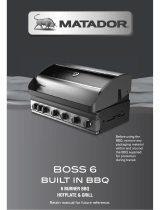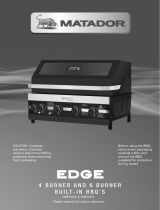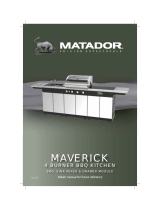
Safety Guide
A strong gas smell or hissing sound of escaping gas indicates a serious problem with the
BBQ or ULPG cylinder. Failure to immediately follow the steps listed below could result
in a fire or explosion that could cause serious injury, death or property damage.
•Shut off gas supply at cylinder
•Turn the control knobs of the BBQ to the off position
•Extinguish any open flame
•Open the BBQ hood
•Get away from the ULPG cylinder
•Do not try and fix the problem yourself
•If gas odour continues or you cannot extinguish fire, call fire brigade
To prevent fire and smoke damage, remove all packaging material before operating
BBQ.
HOSE ASSEMBLY AND SAFETY
A leak test (Procedure located on Page 2 of this manual) must be carried out prior to using
the BBQ for the first time and each time the gas cylinder is refilled, or each time the gas
hose and gas regulator have been disconnected. Check all gas hose and line
connections for damage, cuts or cracks each time you use the BBQ.
If the hose shows signs of deterioration or damage, complete a leak test to identify any
leaks and if required replace the hose.
The hose must remain free of kinks and sharp bends. Never puncture or put stress on
the hose or fittings. Hose connection is located at the lower front area on the right side
wall of the main body of the BBQ.
Replacement hose and regulators can be purchased from your local BBQ retail
specialist. Leak Test procedure is located on Page 2 of this manual.
BURNERS
The location of the tube burner to the jet is vital for safe operation. Check to assure the
jets are inside the burner tubes before using the gas BBQ
SPIDER AND INSECT WEBS
Some times spiders, ants and other insects
climb into the tube burners, gas lines and
other areas of the BBQ. The insects can spin
webs, build nests and lay eggs. The webs or
nests can be very small, but they are very
strong and can block the flow of gas.
NOTE: Complications arising from spider and insect webs built up inside gas
lines are expressly excluded from Warranty
To avoid this occurring, clean burners prior to use, after storing, at the beginning of
your BBQ season or after a period of one month with out use. Guards are on the air
intakes in an effort to reduce this problem, but it will not eliminate it. An obstruction
can result in a “flashback” (a fire in the burner tubes). The burner may still light, but
the obstruction does not allow full gas flow to the burners.
Page 5
























